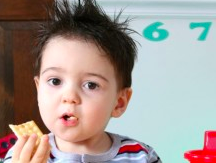ASW
|
 A newborn infant, rocking in the arms of his loving parent just after being fed, feels warm, full, calm, and safe. His needs are met — for now. But soon, his body will use up all of the food, his mother will put him down, and a sound will startle him. When this happens, he feels distress, and, unable to control himself, his only response is to cry out in the hope that a parent will come to protect and comfort him. Again and again you respond to the needs of your child. When infants and children are incapable of meeting their own needs, they depend upon attentive adults — you — to help them regulate those needs. These loving interactions with caring parents form attachment bonds. At the same time, in these same interactions, other crucial areas of the infant's brain are being shaped — including the child's stress response systems. Responding to Stress The brain is continually sensing and responding to the needs of the body. Much of this regulation takes place automatically, beyond our awareness. But as we mature, our brain requires that we actively participate in our own regulation. If we thirst, we seek water; when afraid, we prepare to fight or flee. In short, we self-regulate. When these systems develop normally, we are able to deal with complex and challenging situations with age-appropriate solutions — by adulthood these solutions should be thoughtful and creative. When a child's capacity for self-regulation does not develop normally, he will be at risk for many problems — from persistent tantrums to impulsiveness to difficulty regulating his own sleep and diet. Understanding Your Body's Signals Many of the sensations we feel are clear — thirst, for example. But the body tends to use a common set of sensations for different kinds of potential threats. The feelings caused by frustration are very similar to those caused by fear. A fearful child may act sullen and angry, unaware that he is actually anxious about starting in a new classroom. A hungry child may act distracted, irritable, and non-compliant, again unaware that the internal distress he feels is hunger. Learning to tolerate this distress, correctly label the uncomfortable sensations, and develop appropriate, mature ways to respond to these signals is central to healthy development. Learning to Wait The capacity for self-regulation matures as we grow. The first time your baby felt hunger, he felt discomfort, then distress, and then he cried. You responded. And after many cycles of hunger, discomfort, distress, response, and satisfaction, your baby learned that this feeling of discomfort, even distress, will soon pass. You helped him build the capacity to put a moment between the impulse and the action. With this ability, he will eventually learn to take time to think, plan, and come up with an appropriate response to a challenge. When a Child Needs Support Many children have difficulties with self-regulation because their stress-response systems are poorly organized and hyper-reactive. This could be related to many factors, including genetic predisposition, developmental issues, or exposure to chaos and violence. Children with poor self-regulation can disrupt an entire family. They are often impulsive, difficult to soothe, hypersensitive to transitions, and tend to overreact to minor challenges. If these problems are extreme and persistent, or if the behaviors disrupt the family or classroom, a parent should consider further evaluation. What You Can Do Ways to help children who have not learned to self-regulate:
http://www.scholastic.com/parents/resources/article/social-emotional-skills/developing-self-regulation
0 Comments
Leave a Reply. |
Proudly powered by Weebly

 RSS Feed
RSS Feed